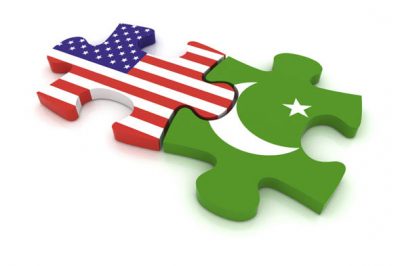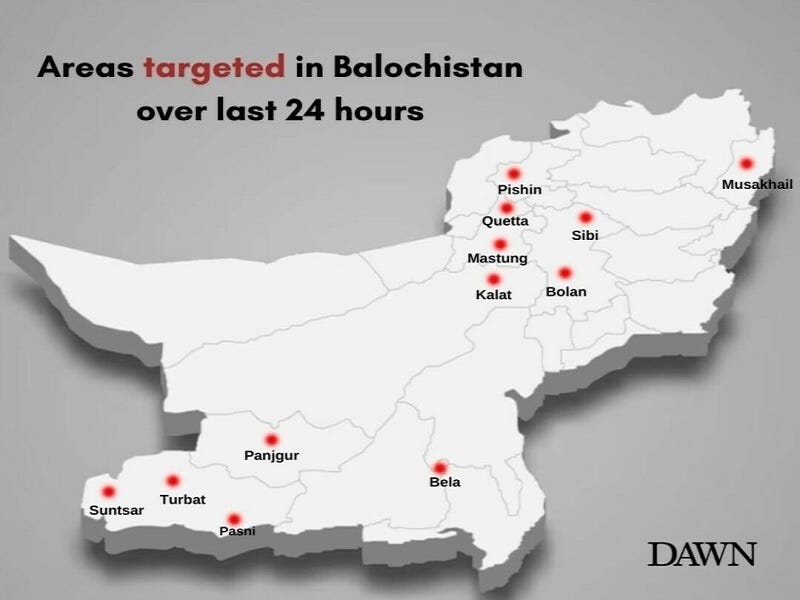The CIA Isn’t Responsible for the Upsurge of Terrorism in Pakistan’s Balochistan Region

Ignoring the decades-old political roots of the Baloch Conflict, their new economic dimension over the past decade since CPEC, and the latest Taliban connections via its TTP partners leads to inaccurate assessments about its latest manifestations and impedes work on a sustainable solution.
An Outdated Explanation
Top Alt-Media influencer Pepe Escobar speculated in a post on Telegram that last week’s spree of terrorist attacks in Pakistan’s Balochistan Region, which included the targeted killing of ethnic Punjabis, was the work of “CIA-financed psychopaths disrupting CPEC.” That’s an outdated explanation though since the US no longer needs to rely on proxies to disrupt BRI’s flagship project after the consequences of April 2022’s post-modern coup against former Prime Minister Imran Khan already did that for it.

The Return of American Influence Over Pakistan
Pakistan shortly thereafter plunged into a major economic-financial crisis that prompted its new American-backed authorities to desperately seek IMF aid, which The Intercept reported last September was only granted in exchange for Pakistan clandestinely arming Ukraine.
It goes without saying that this crisis severely impacted CPEC’s viability, and the People’s Republic has since prioritized alternative connectivity routes through Central Asia and Iran for reaching the Indian Ocean instead.
CPEC is therefore no longer China’s BRI’s flagship project like it initially was in the strategic sense even if it remains one of the largest BRI investments anywhere in the world. The physical infrastructure and power plants that were built during its first phase were supposed to set the stage for unlocking Pakistan’s full economic potential, but the latter hasn’t yet happened and might very well never unfold. The problem is that its post-coup government is now financially indebted to the West with all that entails.
Iranian Chamber of Commerce official Amanollah Kahrazehi recently told local media that “US domination over the government of Pakistan” is responsible for blocking Pakistan’s energy payments to Iran, which observers can intuit also bodes ill for plans to build a long-delayed pipeline between them. This same American influence is also why Pakistan’s reported strategic roadmap for trade with Russia will likely fail to be implemented in full as explained here earlier this summer.
Although Pakistan remains semi-autonomous insofar as it’s refused to vote against Russia at the UN despite American pressure, this is only a superficial expression of sovereignty that shouldn’t mislead observers into ignoring the ways in which American influence has returned to Pakistan since April 2022. There’s also the issue of Pakistan’s deteriorating ties with the Taliban to consider too after its acting Defense Minister accused Pakistan that summer of facilitating US drone activity in Afghanistan.
The Role of Pakistani-Taliban Tensions
Their relations can now be characterized as stuck in a security dilemma that’s seen the Taliban support “Pakistani Taliban” (TTP) terrorists as an asymmetrical response to secretly revived Pakistani-US military cooperation in the aftermath of April 2022’s post-modern coup against its former multipolar premier. To be clear, terrorism can never be justified, but observers should still hear the other side of the story about why the Taliban turned against their decades-long patrons just one year after finally returning to power.
Moving along, it was observed in summer 2023 that “The TTP’s Terrorist Threat To Pakistan Is Metastasizing” after reports that it was allying with terrorist-designated Baloch separatists from the “Baloch Liberation Army” (BLA), who just so happen to be responsible for the latest spree of attacks. Pakistan launched a new counterterrorism operation two months before these tragic events, which this analysis here argued that it likely triggered by Chinese concerns about CPEC’s flagging viability.
BLA terrorist attacks against that megaproject’s terminal port of Gwadar prompted concern from the People’s Republic about whether their Pakistani partners are truly capable of pacifying this restive region, which were further amplified after late July’s large-scale political unrest in that town. Baloch activists marched in defiance of a prohibition on protest activity to draw attention to what they claimed were economic injustices and military abuses against their people.
The authorities implied that this was just a political ploy the BLA, perhaps to distract the security services in order to facilitate more terrorist attacks there or elsewhere in the region, but the fact is that this reminded observers that the decade-long Baloch Conflict is more complex than a simple CIA plot. To oversimplify, its origins relate to the controversial way in which Balochistan joined Pakistan shortly after the latter’s independence, which fueled an insurgency that eventually came to be foreign-backed in part.
The TTP’s Unholy Alliance with the BLA
Pakistan was a US ally during the Old Cold War, which is why there’s no basis to claims that the CIA was responsible for this conflict. Instead, evidence emerged over the years of Afghan, Indian, Iranian, and Soviet support, though all but the first have since ended. Whatever support India and Iran were giving to these groups ended after they revived the North-South Transport Corridor (NSTC) with Russia in 2022 since neither wants instability in Pakistan to spill over into Iran and endanger this megaproject.
The USSR’s dissolution in 1991 ended Moscow’s support for such groups, while the US picked up where it left off in the mid-2010s in order to sabotage CPEC back during the time that it occupied Afghanistan and Pakistan was still on its multipolar trajectory that ended with April 2022’s post-modern coup. The Taliban’s TTP partners then allied with the BLA and associated groups over the next year as was earlier explained, thus leading to the present predicament that’s greatly worsened Afghan-Pakistani ties.
Just like the BLA doesn’t recognize Balochistan’s incorporation into Pakistan, nor does the TTP’s Pashtun ultra-nationalist base recognize the Durand Line between it and Afghanistan, with their shared territorial revisionist goals serving as yet another impetus behind their unholy alliance. Unholy is an accurate description too since these two ultra-nationalist groups have sharp differences over the presence of Pashtuns in northern Balochistan yet have still informally joined forces regardless.
They presumably agreed to disagree on this issue until after they defeat the Pakistani state, or so they expect will happen even though their foe has proven its resilience time and again despite the perceived odds. In any case, the BLA’s ultra-nationalism accounts for why it targeted ethnic Punjabis during their latest spree of terrorist attacks since this group is seen by them as representative of Pakistan’s de facto military rulers who they detest and blame for committing economic injustices against the Baloch people.
The New Pakistani-American Anti-Terrorist Partnership
It’s here where CPEC comes into play since this terrorist group believes that Balochistan won’t benefit much from this megaproject and will only see a fraction of its rich mineral wealth reinvested in the region after extraction. This “resource nationalism” figures prominently into the political and economic dimensions of the long-running Baloch Conflict, whose latest phase began after CPEC’s announcement. Suffice to say, US propaganda egged these groups on at the time, but now the US stands with Pakistan.
The State Department “strongly condemned” last week’s spree of attacks in a tweet and reaffirmed that “We stand with Pakistan in its fight against terrorism”. It should also be mentioned that the US officially designated the BLA as terrorists in 2019, and talk about those two’s former ties is now taboo in post-coup Pakistan, precisely because it could discredit the new authorities’ patrons. Instead, both Pakistan and the US now talk about the Taliban’s ties to terrorism, which serves their interests.
To be sure, there’s truth to their claims that anti-Pakistani terrorists are at the very least active in Afghanistan, if not patronized by the Taliban as an asymmetrical response to the Pakistani-US military cooperation that was secretly revived after April 2022’s post-modern coup. Nevertheless, this could be exploited by the US to justify making the aforementioned cooperation public, let alone possibly pushing Pakistan into initiating conventional cross-border hostilities that could plunge the region back into war.
Whatever may or may not happen, readers now know that the CIA isn’t responsible for the latest upsurge of terrorism in Pakistan’s Balochistan region like Pepe speculated per the outdated model that he relied upon in his post. Ignoring the decades-old political roots of this conflict, their new economic dimension over the past decade since CPEC, and the latest Taliban connections via its TTP partners leads to inaccurate assessments about its latest manifestations and impedes work on a sustainable solution.
Concluding Thoughts
Terrorist-designated forces need to either be disbanded or convinced to disavow violence in favor of political solutions to their region’s multifaceted problems, but the authorities also need to recognize the extent of such problems, only after which is an honest dialogue possible. Separatism isn’t the solution, but nor is the status quo, though a compromise is still a far way off. Well-intentioned observers can contribute to brainstorming a solution, but only if they truly understand this conflict’s origins and dynamics.
*
Click the share button below to email/forward this article to your friends and colleagues. Follow us on Instagram and Twitter and subscribe to our Telegram Channel. Feel free to repost and share widely Global Research articles.
One Month Before Global Research’s Anniversary
This article was originally published on the author’s Substack, Andrew Korybko’s Newsletter.
Andrew Korybko is an American Moscow-based political analyst specializing in the relationship between the US strategy in Afro-Eurasia, China’s One Belt One Road global vision of New Silk Road connectivity, and Hybrid Warfare. He is a regular contributor to Global Research.

